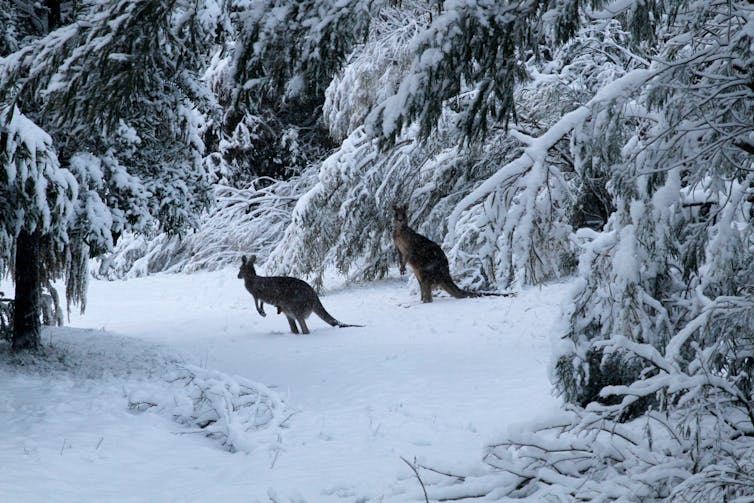Snow at the footy? Just how unusual was last weekend’s weather?
- Written by Andrew King, ARC DECRA fellow, University of Melbourne
Many Australians have just shivered through a cold weekend of wintry weather, with widespread snowfall across Victoria and parts of New South Wales.
The snow was welcomed by skiers and snowboarders alike, with over a metre of snow at the major resorts, but was less fun for people travelling on icy roads across the southeast.
Snow also fell on an AFL match for the first time. So how unusual was last weekend’s dose of winter weather and does a changing climate mean we’ll see more or less snow in winters to come?
Firstly, let’s look at what happened.
A succession of cold fronts brought wind, rain and snow to the southeast of Australia and strong southerly winds kept days and nights much cooler than average. This kind of weather setup where we get sustained southerlies and cold fronts over several days is unusual but by no means unprecedented.
Often, strong cold outbreaks will pass within a day or so, but this event was more prolonged than most because we had multiple blasts of cold air.
Snow fell on and off for two days in places like the Dandenong Ranges and around Orange, and many areas above 1,000 metres in the NSW Central Tablelands were still snow-covered on Monday. Among the lowest places where snow settled were Tumut (New South Wales) and Maldon (Victoria), both at about 300 metres elevation.
Read more: Why snowfall is one of the hardest predictions for a meteorologist
Snow also fell during the AFL match between the GWS Giants and Hawthorn at Canberra on Friday night. While this is the first time snow is known to have fallen during an AFL/VFL match, on average over the last few decades snow falls without settling in Canberra once every year or two. It is only recently matches have started being played in Canberra; until the 1980s, almost all matches were in Melbourne, which has only seen falling snow a handful of times since European settlement.
 Roos in the snow in Lyonville, in Victoria’s Central Highlands.
Nicholas Dunand, Author provided
Roos in the snow in Lyonville, in Victoria’s Central Highlands.
Nicholas Dunand, Author provided
How unusual was it?
When we delve into the past, we can find lots of incidences of widespread snowfalls and freezing conditions in areas of Victoria and New South Wales going back to early British colonisation.
Some of the most memorable widespread events of the past include those of 1900, when 60 centimetres fell in Bathurst; 1965, when snow fell as far north as the ranges west of Mackay; and 1984, when most of the Great Dividing Range was covered as far north as southern Queensland.
The most widespread snowfall of the last 20 years was probably that of May 2000, when snow fell as low as 250 metres in northeast Victoria. 2000 was also the last time substantial snow settled in central Canberra.
Last weekend’s event was probably the most significant snowfall since 2000 in parts of Victoria north of the ranges, and in southern inland New South Wales. In central and northern New South Wales, the last snowfall on this scale was in 2015, while in the hills around Melbourne it was on a par with 2008.
Will snowy winters be a thing of the past?
As the climate warms up, we generally expect to see more of what falls out of the sky to be rain than snow. Winter temperatures across the south of Australia are warming and that’s why it’s become so hard to break existing cold records and much easier to break warm records.
In addition, our rain- and snow-bearing winter storms are tending to move slightly southwards, meaning they miss the south of Australia and head into the Southern Ocean. But that doesn’t mean we shouldn’t expect events like this in the future. They may become less frequent and slightly less cold when they do occur, but we still expect winter cold snaps like this one to remain a feature of a warmer climate.
As many a keen observer of Australia’s ski season will know, a good season can really depend on the timing of a massive cold outbreak like the one we have just experienced. This can make it hard, anecdotally, to see the changes to our ski seasons in real time.
 Howie the Saint Bernard enjoying the snow in Tumut, NSW.
Janet Bird
Howie the Saint Bernard enjoying the snow in Tumut, NSW.
Janet Bird
Analysis of daily snowfall data from the major Victorian ski resorts suggests that while the average number of days in which snow accumulates has declined since the 1990s, the number of heavy snowfall events has remained unchanged.
However, at lower elevations, such as at Bukalong, NSW (790m above sea level), the reduced number of snowfall days and depth is very clear. Over a 50 year time period, there has been a 38% decline per decade in the June maximum snow depth (as a percentage of the June average).
Projections of future snowfall conditions across southeast Australia indicate that while extreme cold events such as last weekend may still occur, it may be harder for snow to stick around once on the ground, with near-surface temperatures expected to increase significantly.
Read more: Why does a bit of snow plunge Britain into transport chaos?
Combining this with a continued decrease in non-extreme snowfall events, largely due to changing air temperatures, has lead climate scientists to predict Australia’s snow-cover will be reduced by about 60% by 2070. This is bad news for endemic alpine species such as the endangered pygmy possum, for our water resources, and also for the snow-obsessed among us who enjoyed our recent winter wonderland.
Authors: Andrew King, ARC DECRA fellow, University of Melbourne
Read more http://theconversation.com/snow-at-the-footy-just-how-unusual-was-last-weekends-weather-121802



